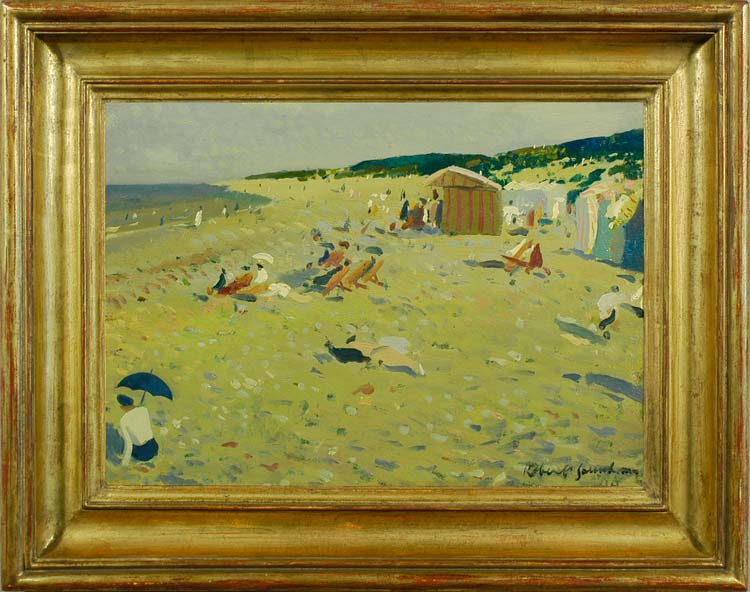One of Greenham’s plein air seaside paintings, probably painted on one of the shingly Suffolk beaches with their low dunes, this shows the English at play in the quiet decades after the war, recalling similar scenes by Bonington and Monet on the Normandy beaches. The light is softer and the North Sea more green and grey than in the Impressionists’ works, investing this serene, sunny seaside, its kiosks, windbrakes and deckchairs, with a sense of utter calm. The composition is influenced by Degas: truncated figures at the edges emphasize the spontaneity of the scene, aided by the wide areas of open space; whilst the broken brushwork recalls Philip Wilson Steer’s paintings of Walberswick beach.
Biographical details
Robert Duckworth Greenham (1906-76) was born in Streatham, the elder brother of Peter Greenham R.A. He trained at the Byam Shaw School of Art and then at the Royal Academy Schools (1926-29), where he was awarded a Landseer Scholarship, Creswick Prize, Silver Medal for painting, and the British Institute Scholarship.
He was a very versatile artist: as well as paintings, he produced etchings, prints, wood engravings and murals. He was perhaps most popular during the period when he was painting coastal and beach scenes, set mainly in Suffolk; other subjects included fêtes, regattas and other, generally outdoor, social occasions. These landscapes and other scenes are characterized by strong outlines and areas of flat colour, rather poster-like in style, where the shapes of deckchairs and parasols take on an almost abstract life. In the 1930s and ’40s Greenham made a series of portraits of actresses and film stars, including Greta Garbo and Jessie Matthews, inspired by cinema stills.
He exhibited regularly at the Royal Academy, New English Art Club and the London Group; at the Royal Society of British Artists and Royal Institute of Oil Painters (to both of which he was elected); the Royal Scottish Academy and the Royal Society of Portrait Painters, as well as many commercial galleries.
Works in public collections include Martita Hunt (after 1943), London, National Portrait Gallery (from the series of portraits of stars, inspired in this case by a photograph for Vogue of Hunt by Cecil Beaton); Portrait of E. Byford, 1928, Braintree District Museum; St Peter Port…, 1974, Guernsey Museums & Galleries.


